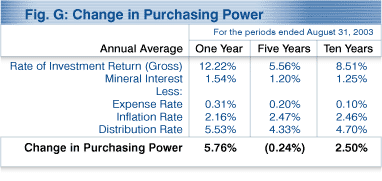|
|
 |
Distribution (or Spending) Policy
 The Constitution directs the UT Board to establish a distribution policy that provides stable, inflation-adjusted distributions to the AUF and preserves the real value of the PUF Investments over the long term. To achieve these goals, the UT Board has adopted a "percent of assets" spending policy for the PUF. Under this policy, the distribution rate is currently set at 4.75% of the prior 12 quarters' average net asset value of the PUF assets, and the dollar distributions will vary with the volatility inherent in financial markets. Although this policy exposes distribution recipients to potentially higher volatility and may result in the loss of nominal or real purchasing power from year to year, it is effective in maintaining the purchasing power of the PUF corpus. This policy was chosen for the PUF because it best suits endowments in which current distributions are small relative to the total budget of the beneficiary and where long term growth of the endowment fund is the key objective as is the case with the PUF. The Constitution directs the UT Board to establish a distribution policy that provides stable, inflation-adjusted distributions to the AUF and preserves the real value of the PUF Investments over the long term. To achieve these goals, the UT Board has adopted a "percent of assets" spending policy for the PUF. Under this policy, the distribution rate is currently set at 4.75% of the prior 12 quarters' average net asset value of the PUF assets, and the dollar distributions will vary with the volatility inherent in financial markets. Although this policy exposes distribution recipients to potentially higher volatility and may result in the loss of nominal or real purchasing power from year to year, it is effective in maintaining the purchasing power of the PUF corpus. This policy was chosen for the PUF because it best suits endowments in which current distributions are small relative to the total budget of the beneficiary and where long term growth of the endowment fund is the key objective as is the case with the PUF.
The UT Board does not, however, have unlimited authority to set the PUF distribution rate. Distributions to the Available University Fund are subject to the following overriding Constitutional conditions:
- Distributions must be at least equal to the amount needed to pay debt service on PUF Bonds;
- Distributions may not increase from the preceding year (except as necessary to pay debt service on PUF Bonds) unless the purchasing power of PUF Investments for any rolling 10-year period has been preserved;
- Distributions may not exceed 7 percent of the average net fair market value of PUF Investments in any fiscal year, except as necessary to pay debt service on PUF Bonds.
Distributions from the PUF to the AUF increased by 7.3% from $338.4 million in fiscal year 2002 to $363.0 million in fiscal year 2003. For the preceding five-year period, starting with the fiscal year ended August 1999, the rate of change in the PUF's annual distribution was 1.5%, 12.8%, 6.6%, 6.7%, and 7.3%, respectively.
As depicted in Figure G, the PUF has achieved the objective of maintaining inflation adjusted value because purchasing power has increased over the ten year period by 2.50%. Fiscal year 2003 provided real growth in the PUF of 5.76%. This growth is retained in the PUF to offset years, such as fiscal years 2002 and 2001, when purchasing power was not maintained. The rate of investment return in Figure G is the gross total return while the net investment return reported in Figure F is net of investment management fees. The expense rate in Figure G includes both investment management fees and other fees.
|
|
|

